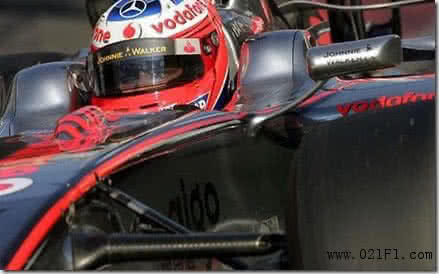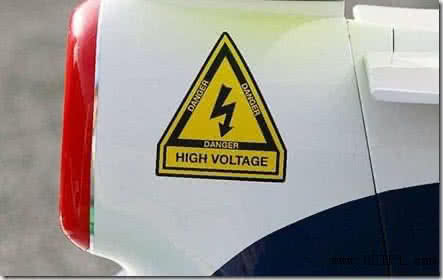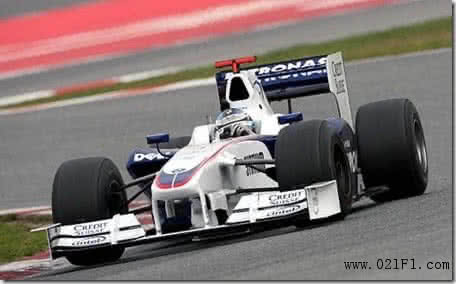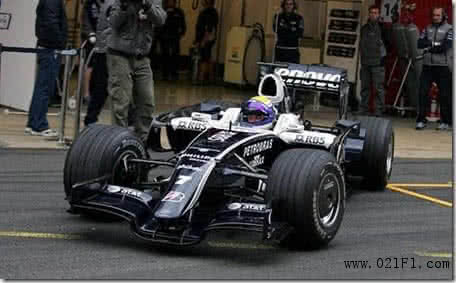- 上海F1票务网获得安全联盟官方认证2013-11-22
- 莱科宁被曝遭跃马炒鱿鱼 法拉利否认这一消息2014-06-11
- 国际汽联为什么推迟换胎新规的实施?为了安全起见2021-07-26
- 中国F1第一人马青骅 参加年轻车手测试首亮相2012-07-13
- 格罗斯让F1巴林站事故调查结果公布2021-03-12
- 曝汉密尔顿将与梅奔续约期为两年,小汉必须作出让步2021-02-01
- 维特尔2013F1韩国站再次夺冠 实现韩国站三连冠2013-10-07
- F1揭幕战阿隆索严重撞车事故:F1赛车靠什么比家用车更安全2016-03-23
- 2020赛季F1日程安排:中国站4月19日2020-01-18
- 上海赛车场卡丁车场6月营业时间公布2021-05-28
2011年F1新规则
近年来,FIA对于F1比赛规则的更改力度一年大过一年,09年更是如此。
2009年F1新规则
Tyres (轮胎)
After 10 seasons on grooved tyres, Formula One racing returns to slicks in 2009, as part of moves to increase the emphasis on mechanical rather than aerodynamic grip. With no grooves, grip will increase by around 20 percent, bringing a significant performance gain. However, that gain will be offset by the vastly reduced downforce levels of the revised aerodynamic regulations (see below). The overall effect should be reduced performance through high-speed corners. Drivers will still have the choice of two dry tyre compounds and will still have to use both compounds during a race.
09年将重新使用光头胎来取代沿用了10年之久的带沟槽的干地胎。10年前启用沟槽轮胎是为了抑制F1赛车间日益疯狂的急速提升竞赛,不过近年来在各车队不遗余力发展空力套件的大环境下,这项措施的效果越发杯水车薪。在权衡赛车安全性之后,FIA重新启用了光头胎,在增大轮胎接地面积的作用下,此举可以提高20%的赛车机械抓地力,有效增加行使中的操控性和安全性,同时也可以减小对于空力套件的需求,此点对于中小车队无疑是一个大大利好的消息,发展空力套件是一件相当费时费钱的系统工程。

Slicks on Mclaren Mercedes 2009 interim car
KERS (动力回收系统)
From 2009 teams have the option of employing a Kinetic Energy Recovery System (KERS) to boost their car’s performance. As its name implies, a KERS recovers the (normally wasted) kinetic energy generated by the car’s braking process. This energy is stored using a mechanical flywheel or an electrical battery and then made available to the driver, in set amounts per lap, via a ‘boost button’ on the steering wheel. Under the current regulations the power gain equates to around 80 horsepower, available for just under seven seconds per lap. This could be worth several tenths of a second in terms of lap time, but the weight and packaging of the system – and its impact on the car’s weight distribution – also have to be taken into account.
KERS系统,动力回收系统,将赛车制动时浪费的动力进行储存,然后作为额外动力使用的系统(据说使用时的效果类似N2O),按照现行规则,经由KERS系统回收提供的动力相当于80马力,每圈可使用不超过7秒。09年,KERS系统仅作为各车队的可选部件,毕竟KERS的安装无疑将会影响的赛车的重量分配等等方面,这一全新的系统的效果究竟如何还不能预估,不过其在超车时所能起到的作用不可否认。

High voltage KERS warning sticker on the Honda airbox
Engines (引擎)
In a move designed to boost reliability still further, drivers must now use the same engine for three, rather than two, consecutive events. There are also plans for measures to equalise engine performance between teams. How this will be achieved has not yet been finalised.
09年的引擎规则在08年两站引擎的基础上提高到三战,FIA还有计划通过某些措施来减小各车队引擎之间的差距,具体通过何种方式还没有定论。
Aerodynamics (空力套件)
Along with slick tyres, this is the biggest area of change for 2009. Downforce will be dramatically reduced and the cars’ bodywork will appear much cleaner, thanks to new dimensional regulations that effectively outlaw extraneous items such as barge boards, winglets, turning vanes and chimneys.
As well as reducing overall aero performance, the revisions are also designed to increase overtaking by making the car less susceptible to turbulence when closely following another driver. The most obvious changes are to the front and rear wings.
The front wing becomes lower (75mm from 150mm) and wider (up from 1400 to 1800mm – the same width as the car) with driver-adjustable flaps. Drivers will be allowed to make two wing adjustments per lap, altering the wing angle over a six-degree range.
The rear wing becomes taller (up 150mm to bring it level with the top of the engine cover) and narrower (750mm from 1000mm).
Also at the back of the car, the diffuser has been moved rearwards, its leading edge now level with (rather than ahead of) the rear-wheel axle line. In addition, the diffuser has been made longer and higher, all changes that will reduce its ability to generate downforce.
光头胎的使用大幅提高了赛车的机械抓地力,从而对于空力套件的改变是巨大的,明年的赛车将一改近年来空力套件复杂化的发展趋势,伴随着小翼等套件的减少,赛车将显得“干净”不少。另外再加上对于赛车外围尺寸规则的改变,包括前翼、尾翼、尾部扩散器在内的主要空力部分将会有大幅度的改变。
这些部分的改变使得明年的F1赛车将会呈现一个相当不同于以往的造型,个人觉得把赛车给整难看了不少,感觉相当之奇怪,尤其是那个变窄变高了的尾翼(车手在行驶中可调整尾翼角度,2次/圈),对于减小了面积的尾翼,不知道赞助商们是不是也可以减少他们的广告费呢?
如图所示:

BMW Sauber F1 2009 interim car

Williams 2009 interim car
Testing (测试)
2008’s testing allowance of 30,000 kilometres is expected to be slashed by a third to 20,000 in a bid to further reduce development costs.
09年的赛车测试里程从08年的30000公里减少的20000公里,估计是继混合燃料、KERS系统之后又一项响应全球环保号召的举措吧。
